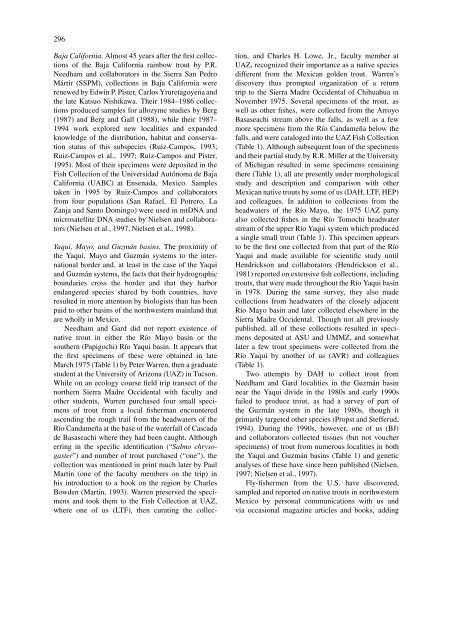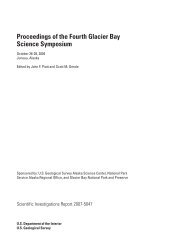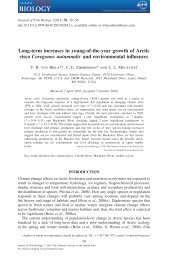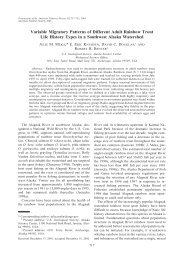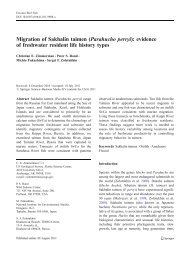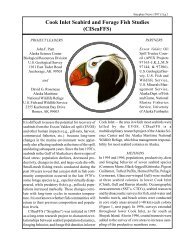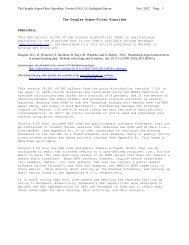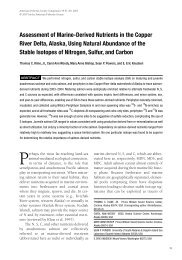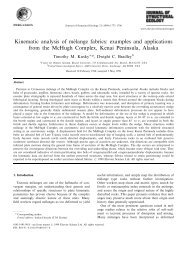Mexican native trouts: a review of their history and ... - Webspace
Mexican native trouts: a review of their history and ... - Webspace
Mexican native trouts: a review of their history and ... - Webspace
Create successful ePaper yourself
Turn your PDF publications into a flip-book with our unique Google optimized e-Paper software.
296<br />
Baja California. Almost 45 years after the first collections<br />
<strong>of</strong> the Baja California rainbow trout by P.R.<br />
Needham <strong>and</strong> collaborators in the Sierra San Pedro<br />
Mártir (SSPM), collections in Baja California were<br />
renewed by Edwin P. Pister, Carlos Yruretagoyena <strong>and</strong><br />
the late Katsuo Nishikawa. Their 1984–1986 collections<br />
produced samples for allozyme studies by Berg<br />
(1987) <strong>and</strong> Berg <strong>and</strong> Gall (1988), while <strong>their</strong> 1987–<br />
1994 work explored new localities <strong>and</strong> exp<strong>and</strong>ed<br />
knowledge <strong>of</strong> the distribution, habitat <strong>and</strong> conservation<br />
status <strong>of</strong> this subspecies (Ruiz-Campos, 1993;<br />
Ruiz-Campos et al., 1997; Ruiz-Campos <strong>and</strong> Pister,<br />
1995). Most <strong>of</strong> <strong>their</strong> specimens were deposited in the<br />
Fish Collection <strong>of</strong> the Universidad Autónoma de Baja<br />
California (UABC) at Ensenada, Mexico. Samples<br />
taken in 1995 by Ruiz-Campos <strong>and</strong> collaborators<br />
from four populations (San Rafael, El Potrero, La<br />
Zanja <strong>and</strong> Santo Domingo) were used in mtDNA <strong>and</strong><br />
microsatellite DNA studies by Nielsen <strong>and</strong> collaborators<br />
(Nielsen et al., 1997, Nielsen et al., 1998).<br />
Yaqui, Mayo, <strong>and</strong> Guzmán basins. The proximity <strong>of</strong><br />
the Yaqui, Mayo <strong>and</strong> Guzmán systems to the international<br />
border <strong>and</strong>, at least in the case <strong>of</strong> the Yaqui<br />
<strong>and</strong> Guzmán systems, the facts that <strong>their</strong> hydrographic<br />
boundaries cross the border <strong>and</strong> that they harbor<br />
endangered species shared by both countries, have<br />
resulted in more attention by biologists than has been<br />
paid to other basins <strong>of</strong> the northwestern mainl<strong>and</strong> that<br />
are wholly in Mexico.<br />
Needham <strong>and</strong> Gard did not report existence <strong>of</strong><br />
<strong>native</strong> trout in either the Río Mayo basin or the<br />
southern (Papigochi) Río Yaqui basin. It appears that<br />
the first specimens <strong>of</strong> these were obtained in late<br />
March 1975 (Table 1) by Peter Warren, then a graduate<br />
student at the University <strong>of</strong> Arizona (UAZ) in Tucson.<br />
While on an ecology course field trip transect <strong>of</strong> the<br />
northern Sierra Madre Occidental with faculty <strong>and</strong><br />
other students, Warren purchased four small specimens<br />
<strong>of</strong> trout from a local fisherman encountered<br />
ascending the rough trail from the headwaters <strong>of</strong> the<br />
Río C<strong>and</strong>ameña at the base <strong>of</strong> the waterfall <strong>of</strong> Cascada<br />
de Basaseachi where they had been caught. Although<br />
erring in the specific identification (“Salmo chrysogaster”)<br />
<strong>and</strong> number <strong>of</strong> trout purchased (“one”), the<br />
collection was mentioned in print much later by Paul<br />
Martin (one <strong>of</strong> the faculty members on the trip) in<br />
his introduction to a book on the region by Charles<br />
Bowden (Martin, 1993). Warren preserved the specimens<br />
<strong>and</strong> took them to the Fish Collection at UAZ,<br />
where one <strong>of</strong> us (LTF), then curating the collection,<br />
<strong>and</strong> Charles H. Lowe, Jr., faculty member at<br />
UAZ, recognized <strong>their</strong> importance as a <strong>native</strong> species<br />
different from the <strong>Mexican</strong> golden trout. Warren’s<br />
discovery thus prompted organization <strong>of</strong> a return<br />
trip to the Sierra Madre Occidental <strong>of</strong> Chihuahua in<br />
November 1975. Several specimens <strong>of</strong> the trout, as<br />
well as other fishes, were collected from the Arroyo<br />
Basaseachi stream above the falls, as well as a few<br />
more specimens from the Río C<strong>and</strong>ameña below the<br />
falls, <strong>and</strong> were cataloged into the UAZ Fish Collection<br />
(Table 1). Although subsequent loan <strong>of</strong> the specimens<br />
<strong>and</strong> <strong>their</strong> partial study by R.R. Miller at the University<br />
<strong>of</strong> Michigan resulted in some specimens remaining<br />
there (Table 1), all are presently under morphological<br />
study <strong>and</strong> description <strong>and</strong> comparison with other<br />
<strong>Mexican</strong> <strong>native</strong> <strong>trouts</strong> by some <strong>of</strong> us (DAH, LTF, HEP)<br />
<strong>and</strong> colleagues. In addition to collections from the<br />
headwaters <strong>of</strong> the Río Mayo, the 1975 UAZ party<br />
also collected fishes in the Río Tomochi headwater<br />
stream <strong>of</strong> the upper Río Yaqui system which produced<br />
a single small trout (Table 1). This specimen appears<br />
to be the first one collected from that part <strong>of</strong> the Río<br />
Yaqui <strong>and</strong> made available for scientific study until<br />
Hendrickson <strong>and</strong> collaborators (Hendrickson et al.,<br />
1981) reported on extensive fish collections, including<br />
<strong>trouts</strong>, that were made throughout the Río Yaqui basin<br />
in 1978. During the same survey, they also made<br />
collections from headwaters <strong>of</strong> the closely adjacent<br />
Río Mayo basin <strong>and</strong> later collected elsewhere in the<br />
Sierra Madre Occidental. Though not all previously<br />
published, all <strong>of</strong> these collections resulted in specimens<br />
deposited at ASU <strong>and</strong> UMMZ, <strong>and</strong> somewhat<br />
later a few trout specimens were collected from the<br />
Río Yaqui by another <strong>of</strong> us (AVR) <strong>and</strong> colleagues<br />
(Table 1).<br />
Two attempts by DAH to collect trout from<br />
Needham <strong>and</strong> Gard localities in the Guzmán basin<br />
near the Yaqui divide in the 1980s <strong>and</strong> early 1990s<br />
failed to produce trout, as had a survey <strong>of</strong> part <strong>of</strong><br />
the Guzmán system in the late 1980s, though it<br />
primarily targeted other species (Propst <strong>and</strong> Stefferud,<br />
1994). During the 1990s, however, one <strong>of</strong> us (BJ)<br />
<strong>and</strong> collaborators collected tissues (but not voucher<br />
specimens) <strong>of</strong> trout from numerous localities in both<br />
the Yaqui <strong>and</strong> Guzmán basins (Table 1) <strong>and</strong> genetic<br />
analyses <strong>of</strong> these have since been published (Nielsen,<br />
1997; Nielsen et al., 1997).<br />
Fly-fishermen from the U.S. have discovered,<br />
sampled <strong>and</strong> reported on <strong>native</strong> <strong>trouts</strong> in northwestern<br />
Mexico by personal communications with us <strong>and</strong><br />
via occasional magazine articles <strong>and</strong> books, adding


